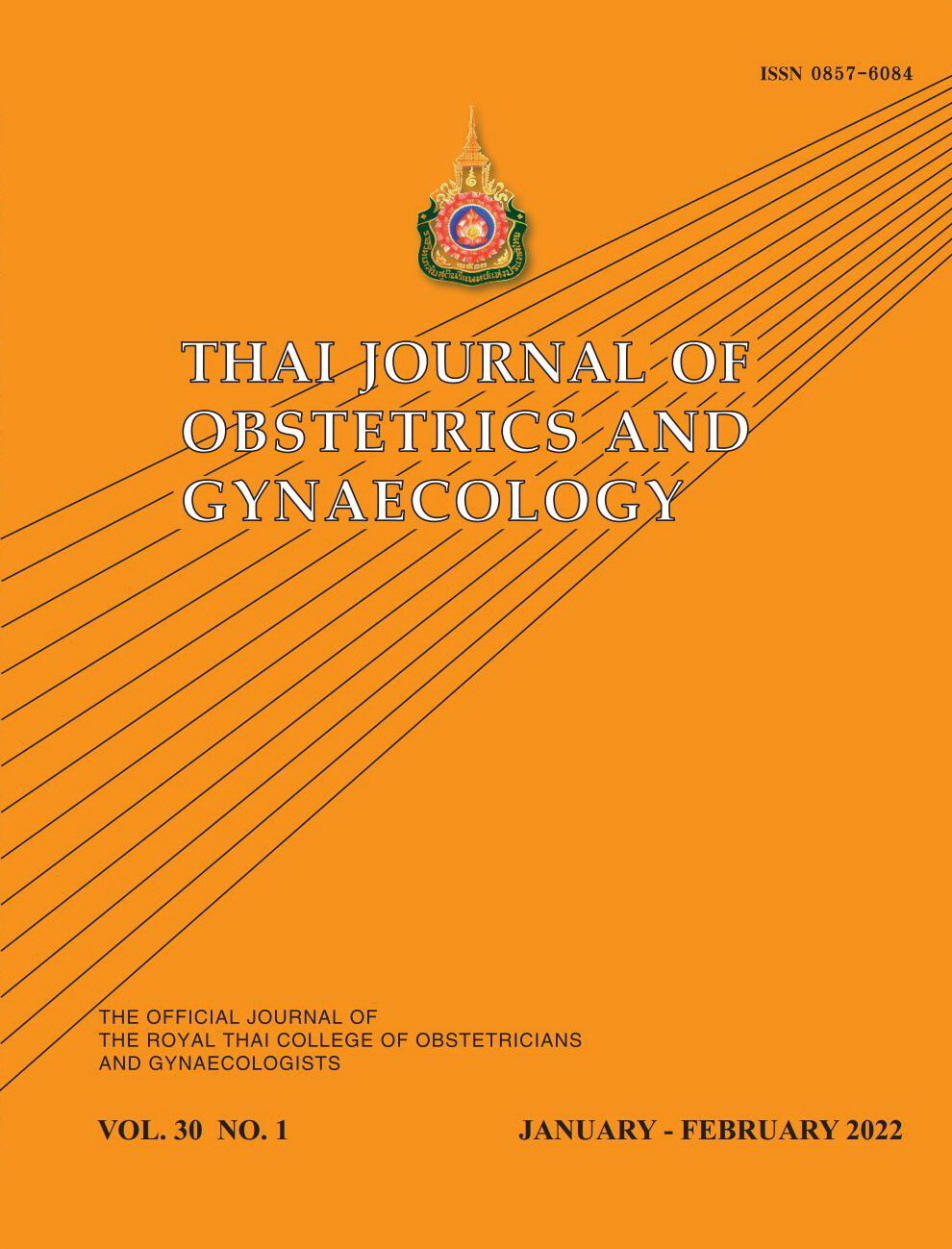Use of Placental Pulsatility Index in High Risk Pregnancy to Predict Fetal Growth Restriction
Main Article Content
Abstract
Objectives: The primary objective was to determine the predictive value of placental pulsatility index (PPI) in its ability to predict fetal growth restriction in singleton pregnant women at 16-24 weeks of gestation. The secondary objective was to evaluate PPI in predicting adverse perinatal outcomes and to compare the efficacy of PPI with conventional uterine artery pulsatility index (UtA PI) or umbilical artery pulsatility index (UA PI) alone.
Materials and Methods: A prospective observational study enrolled singleton pregnant women at 16- 24 weeks of gestation who were at high risk for fetal growth restriction and had prenatal care at the King Chulalongkorn Memorial Hospital between February 12, 2018, and January 28, 2019. UtA PI and UA PI were performed and calculated as PPI by transabdominal ultrasonography. Pregnancy outcomes were recorded. The optimal cut-off for PPI was derived from the receiver operating characteristic (ROC) curve to calculate the predictive values for fetal growth restriction.
Results: A total of 446 pregnant women were enrolled into the study. Twenty-seven cases (6%) developed fetal growth restriction. The optimal cut-off for PPI at 16-24 weeks of gestation was 1.38. The sensitivity, specificity, positive predictive value, and negative predictive value to predict fetal growth restriction were 66.7%, 78.8%, 16.8%, and 97.3%, respectively. The ROC curve of the PPI gave an area under the curve of 0.73 (95% CI,0.61-0.84).
Conclusion: In second-trimester high-risk pregnancies, PPI had a comparable performance in predicting FGR and adverse perinatal outcomes compared to UtA PI alone.
Article Details

This work is licensed under a Creative Commons Attribution-NonCommercial-NoDerivatives 4.0 International License.
References
ACOG Practice bulletin no. 134: fetal growth restriction. Obstet Gynecol 2013;121:1122-33.
Alfirevic Z, Stampalija T, Gyte GM. Fetal and umbilical Doppler ultrasound in normal pregnancy. Cochrane Database Syst Rev 2010; 4:CD001450.
Lee AC, Katz J, Blencowe H, Cousens S, Kozuki N, Vogel JP, et al; CHERG SGA-Preterm Birth Working Group. National and regional estimates of term and preterm babies born small for gestational age in 138 low-income and middle-income countries in 2010. Lancet Glob Health 2013;1:e26-36.
Patient statistics report from delivery room 2017, Department of Obstetrics - Gynecology, King Chulalongkorn Memorial Hospital.
Bower S, Schuchter K, Campbell S. Doppler ultrasound screening as part of routine antenatal scanning: prediction of pre-eclampsia and intrauterine growth retardation. Br J Obstet Gynaecol 1993;100:989-94.
De Paco C, Ventura W, Oliva R, Miguel M, Arteaga A, Nieto A, et al. Umbilical artery Doppler at 19 to 22 weeks of gestation in the prediction of adverse pregnancy outcomes. Prenat Diagn 2014;34:711-5.
Gudmundsson S, Flo K, Ghosh G, Wilsgaard T, Acharya G. Placental pulsatility index: a new, more sensitive parameter for predicting adverse outcome in pregnancies suspected of fetal growth restriction. Acta Obstet Gynecol Scand 2017;96:216-22.
Cnossen JS, Morris RK, ter Riet G, Mol BW, van der Post JA, Coomarasamy A, et al. Use of uterine artery Doppler ultrasonography to predict pre-eclampsia and intrauterine growth restriction: a systematic review and bivariable meta-analysis. CMAJ 2008;178:701-11.
Ghosh GS, Gudmundsson S. Uterine and umbilical artery Doppler are comparable in predicting perinatal outcome of growth-restricted fetuses. BJOG 2009;116:424-30.
Parra-Saavedra M, Crovetto F, Triunfo S, Savchev S, Peguero A, Nadal A, Gratacós E, Figueras F. Association of Doppler parameters with placental signs of underperfusion in late-onset small-for-gestational- age pregnancies. Ultrasound Obstet Gynecol 2014;44:330-7.
Li N, Ghosh G, Gudmundsson S. Uterine artery Doppler in high-risk pregnancies at 23-24 gestational weeks is of value in predicting adverse outcome of pregnancy and selecting cases for more intense surveillance. Acta Obstet Gynecol Scand 2014;93:1276-81.
García B, Llurba E, Valle L, Gómez-Roig MD, Juan M, Pérez-Matos C, et al. Do knowledge of uterine artery resistance in the second trimester and targeted surveillance improve maternal and perinatal outcome? UTOPIA study: a randomized controlled trial. Ultrasound Obstet Gynecol 2016;47:680-9.
Urbairojkit B. Fetal growth restriction. In : Charoenvidhya D, Urbairojkit B , Manotaya S, Tanawattanacharoen S, Panyakhamlerd K, editors. Obstretrics.3rd edition.Bangkok:O. S. Printing House 2005:341-50.
Bhide A, Acharya G, Bilardo CM, Brezinka C, Cafici D, Hernandez-Andrade E, et al. ISUOG practice guidelines: use of Doppler ultrasonography in obstetrics. Ultrasound Obstet Gynecol 2013;41:233-9.
Nagar T, Sharma D, Choudhary M, Khoiwal S, Nagar RP, Pandita A. The Role of Uterine and Umbilical Arterial Doppler in High-risk Pregnancy: A Prospective Observational Study from India. Clin Med Insights Reprod Health 2015;9:1-5.
Pongrojpaw D, Chanthasenanont A, Nanthakomon T. Second trimester uterine artery Doppler screening in prediction of adverse pregnancy outcome in high risk women. J Med Assoc Thai 2010;93 Suppl 7:S127-30.


